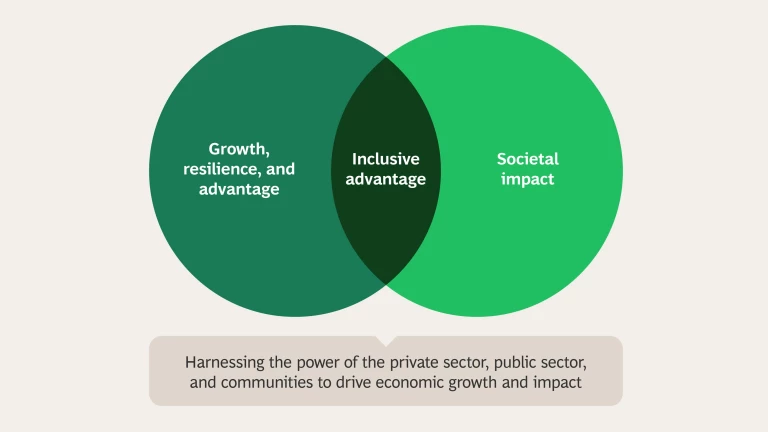インクルージョン戦略に関するBCGのコンサルティングサービス
関連するサービス
インクルージョン戦略に関するBCGのアプローチ
多くの組織が人材不足という課題に直面しています。多様な人材が尊重され共存するインクルーシブな職場づくりは、従業員全体の恩恵につながります。定着率の高い優れた人材基盤を築くうえで、欠かせない取り組みといえます。また、社会の多様性が高まるなか、サービスが十分に行き届いていない層に向けて新しい市場を開拓する機会が生まれつつあります。BCGは、クライアントの皆様が戦略を再構築し、さらに広い視野を持てるよう支援します。私たちが目指すのは、持続的な優位性と収益性を可能にするソリューションを実現すると同時に、社会的インパクトを創出することです。

- 公正でインクルーシブなサプライチェーンの構築: 多様なサプライヤープログラムを設け、取引先とのエンゲージメントを強化し、人権・労働基準の順守を支援するチェックツールなどを取り入れます。
- パーソナライズされた従業員価値提案(EVP): 現場の従業員の個々のニーズに対応することで、人材獲得力を高め、組織の生産性の向上を図ります。
- 新たな顧客・市場の開拓とビジネスモデルの革新: 成長を促進しながら、まだニーズが充たされていない非効率な市場やセグメントに対応していきます。
インクルージョン戦略に関するBCGのクライアント支援事例

社会変革をもたらすビジネスを実現した事例: あるグローバル製薬企業と連携し、同社が米国やEUで特許を取得している医薬品・ワクチンを、45の低所得国に対して非営利で提供できるようサポートしました。BCGは、ポートフォリオの開発や規制対応、サプライチェーン・プラットフォーム、医療従事者向けの教育に関する専門的知見を活かし、この企業の取り組みを支援しました。同社は医薬品・ワクチンの提供プログラムを立ち上げ、12億人の命を救う治療を届けることが可能になりました。

データ活用によりインクルージョンを競争優位性につなげた事例: ある中米の通信会社と協働し、定量データと定性データの両方を分析したイノベーション・ハッカソンを実施しました。同社はこの取り組みを通じて、従業員全体に役立つプログラムを設計し、自社の戦略を強化するとともに従業員の成果改善を実現しました。

障害のある人々を支援する戦略を策定した事例: ある中東の政府と連携し、障害のある市民の生活を包括的に支援する戦略を策定しました。世界の先進事例を取り入れたこの戦略は、誰もが力を発揮できる労働環境を整え、健康や教育の質を高め、より良い福祉サービスを効率的に提供することを目指しています。
金融包摂(ファイナンシャル・インクルージョン)戦略を策定した事例: 大手金融サービス企業と協働し、市場のニーズに沿った形で、金融包摂戦略を策定しました。プロジェクトでは360万人の顧客データを分析し、「銀行口座を持たない状態から経済的に健全な暮らしに至るまで」のプロセスを可視化。地域ごとの障壁と解決策を明らかにしました。さらに、金融包摂の実現に向けて、エコシステム内のさまざまなプレーヤーが実行できる具体策を設計しました。この取り組みによって、消費者のウェルビーイング向上と企業の成長の双方を後押しする、幅広く応用可能なフレームワークが生まれました。
中小企業の成長を後押しした事例: フォーチュン500に名を連ねる大手小売企業と協働し、製品イノベーションの強化、地域顧客へのリーチ拡大、サプライヤーのロイヤルティ向上などに取り組み、成長戦略の実現を支援しました。まず、中小企業のサプライヤーが持続的に、迅速な成長を遂げるために必要なものを分析しました。その結果、主な課題は「資金調達」「市場と顧客」「相談先と専門知識」へのアクセスであることが明らかになりました。

Client Impact
BCG partnered with a global payments firm to develop data-driven strategies that go beyond access—supporting financial growth for their customers. Learn more.
ダイバーシティ/エクイティ/インクルージョン エキスパート
BCGのダイバーシティ/エクイティ/インクルージョン領域のコンサルティングチームは、民間および公的セクターと協働してダイバーシティ戦略の策定や、職場におけるDEI推進のためのソリューション開発に取り組んでいます。この分野におけるBCGのエキスパートをご紹介します。






ダイバーシティ/エクイティ/インクルージョン 最近の論考など
Video
The $10 Trillion Opportunity in Inclusive Finance
Four billion people are excluded from the financial system. Tala’s Shivani Siroya shares how new technologies are helping to expand access—and why we all benefit.

Employers underestimate how many PwD work for them, so they are missing opportunities to improve inclusion and retention. Here’s how they can do better.



